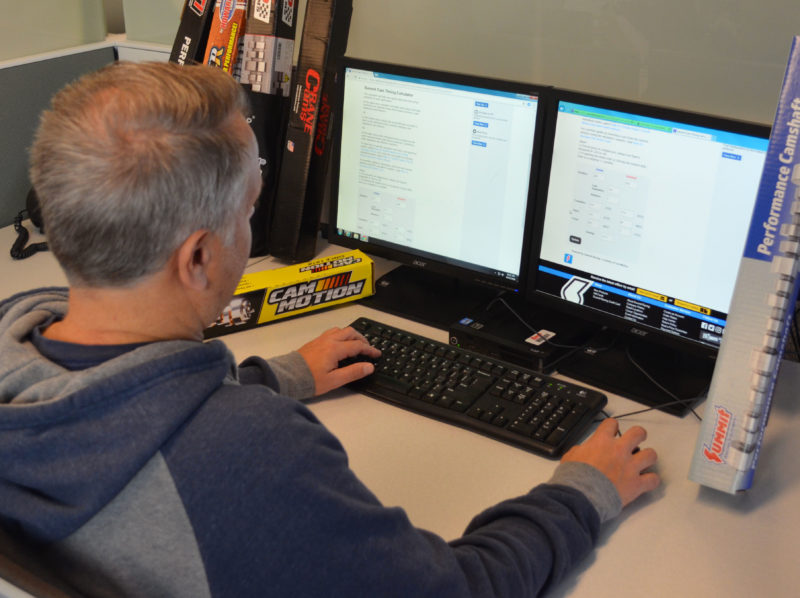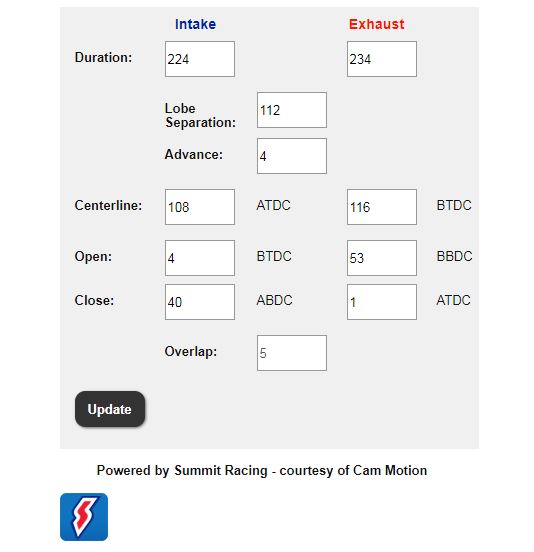
It isn’t always obvious which camshaft we should choose for our engine build.
Even when we fully understand the individual timing events and how each of them interact in a four-stroke engine’s piston and valve motion, the complexity of it all can bring confusion and uncertainty to the cam selection process.
We just learned about a new tool that pretty much eliminates the confusion and uncertainty, courtesy of our friends at Summit Racing, and their partners in developing it—the cam experts at Cam Motion.
That new tool—your new secret weapon—is the new Summit Racing Cam Timing Calculator.
How the Cam Timing Calculator Works
The Summit Racing Cam Timing Calculator does two things:
- It converts duration, lobe separation, and advance into the four individual timing events that will ultimately dictate engine performance.
- It also works the opposite way. You can tweak any of the four events in the calculator to learn what the resulting duration, lobe separation, and advance would be under the new conditions.
No matter what engine or application you’re building it for, you can quickly compare specs and how they differ under different running conditions.
For examples, check out this video:
…
[NOTE: Looking for the Summit Racing Cam Timing Calculator? Find it and several other helpful calculators and tools to help you determine compression ratio, gear ratio, CFM requirements, and more on Summit Racing’s Calculators and Tools page.]
…
Understanding the 4 Key Individual Timing Events for Camshaft Selection
Let’s back up for a minute.
In previous articles, we’ve talked about the importance of Considering Individual Timing Events When Choosing a Cam to help us determine the duration, lobe separation and advance needed. This is especially important for cars with electronic injection which are dependent on idle vacuum to run correctly.
Here’s a quick recap of the four events in order of importance:
1. Intake Valve Closing (IVC)
This event has the most control over the powerband. We trade low-end torque for high-end horsepower when we close the intake valve later after BDC.
2. Intake Valve Opening (IVO)
This is the first component in overlap and the most important to idle quality. The idle gets rougher when we open the valve earlier BTDC, but we net more airflow on the intake stroke.
3. Exhaust Valve Closing (EVC)
This is the second component in overlap and is a compromise between reversion at low rpm and part throttle and the positive effects of scavenging higher in the power band and WOT.
4. Exhaust Valve Opening (EVO)
This is the least critical of the four events due to high residual cylinder pressure blasting out of the cylinder even before the piston hits BDC. It helps rid the cylinder of burnt gasses, but it’s a compromise. Opening too early before BDC decreases pressure on the piston that could be used to turn the crank, but reduces pumping losses. Pumping losses are caused by pressure working against the piston when it’s on the upstroke after BDC.
…
For a better understanding of the how’s and why’s behind tweaking individual valve events, check out this video which will help guide you on the path to mastering cam timing.


Hola os escribo de Gran Canaria España estoy interesado en comprar el software cam Simulator pero no consigo ver precio y como comprarĺo Saludos
Hola desde Canarias España como puedo comprar softwares
i really like it and if it possible to know how to calculate valve lift @ tdc and why it is so important to have a big number
thanks
[…] 2. Camshaft Secret Weapon: Choose Perfect Cam with New … […]
Ok i must be doing it wrong can you help.i have a stock 66 327 chevy been rebuilt stock specs its in 57 Chevy pickup 350trans 342gears trans am posi.edelbrk performer 600 carb an headers.im stuck between cl12-206 or cl12-211 comp cam kit.?
Have a 434 Dart in a Topolino , 700 kg, Afr 220 heads , scat rotating assenbly 4600 stall, 12:1 comp single plane (Victor ) . Rev range 5000 _ 7000 . Solid roller cam 850 holley . What would you advise as a suitable cam , 100 pump gas , strip only . Thank you Peter,, Would a dual plane be more suitable ? I feel there’s more HP to be tapped .
Hi,
I am building a VQ37 VHR engine with forced induction.
Looking at stroking the engine to a 4.2 or 4.3 litre.
I am interested at improving HP gains, can you recommend a exhaust cam which would suit.
Currently looking at:
JWT C2 Exhaust Cam Set
261 degrees .456 lift
vs
JUN Auto High Lift Camshafts
68/ 272 degrees 11mm lift
72/ 288 degrees 11mm lift
Any Oother recommendations??
I understand a shorter duration of lift under the curve, gives fairly broad powerband.
Car will be street driven & occasional track day.
What would you recommend??